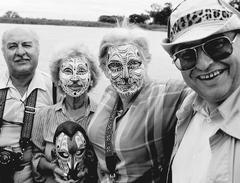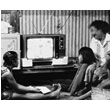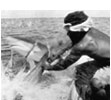Art Review from the New York Times
4 May 2005

April 29, 2005
ART REVIEW | 'UNIVERSAL EXPERIENCE'
Eager Globe-Trotters Shrink the Art World
By KEN JOHNSON
CHICAGO - If Voltaire were still around to tell the story of globalization, two of his principal character types would be the enlightened, transnational citizen of the world and his imbecilic twin, the tourist. The second of these, a figure much reviled by globally minded sophisticates these days, is nominally the subject of a big, ambitious exhibition at the Museum of Contemporary Art here, called "Universal Experience: Art, Life and the Tourist's Eye."
Occupying the whole museum and populated by numerous darlings of the international art circuit - Rirkrit Tiravanija, Doug Aitken, Maurizio Cattelan, Thomas Hirschhorn and Tacita Dean, among others - the exhibition was organized by the museum's senior curator, Francesco Bonami.
If you expect the show to focus specifically on tourists and tourism, you may find it confusing. Among the works of photography, video, sculpture and installation (painting is conspicuously absent) are many things that do not obviously pertain to tourism. Surrealistic sculptures by Urs Fischer, Jeff Koons's stainless steel bunny, a pile of candy by Felix Gonzalez-Torres and a deep purple wall sculpture by Anish Kapoor are some examples. Modern travel, however, is the thematic glue that holds the show together, and the interest is sharpened by tension between enlightened cosmopolitanism and the tourist's brainless consumerism.
The art world's prime example of enlightened cosmopolitanism is Mr. Tiravanija, the globe-traveling conceptualist with a Thai passport and a home base in New York. He is represented by the remnants of a 1994 performance: an old bicycle outfitted with a video camera, a folding table and camping equipment. The artist walked the bicycle from the Madrid Airport to the Reina Sofia Museum in the city, and his experiences with people and places along the way became part of the art that was subsequently displayed in a show at the museum.
It was an exercise in what you might call exemplary anti-tourism - a way of traveling that takes the time to experience a place slowly, sensitively and intimately in its own terms.
The opposite of Mr. Tiravanija's gentle cosmopolitanism is represented by Alexander Timtschenko's large, glossy color photographs of sites in Las Vegas that mimic other places and times, like the Eiffel Tower in Paris and the American Wild West. To similar effect, Hiroshi Sugimoto presents a life-size multipanel photograph of Leonardo's "Last Supper," rendered in hyper-realistic three dimensions in a Japanese wax museum.
The implicit message is that places like these would not exist were it not for yahoos with too much time and money who can't or don't care to differentiate between high-quality culture and junk culture, or between the real and the fake.
A darker reflection of tourism is Darren Almond's double video projection of seemingly old grainy black-and-white films of bus stops in Auschwitz, at one of which visitors wait to be taken to visit the site of the concentration camp. But the most appalling representation of tourism is a video by Dennis O'Rourke that documents ditzy American and Australian tourists visiting and photographing tribes in New Guinea that they have been led to believe still practice cannibalism. But the impoverished, puzzled and, in some cases, angry natives want only to sell photo opportunities and their wooden carvings.
The excellent catalog, which consists mainly of excerpts from the writings about travel by many different people - including Bruce Chatwin, Susan Sontag and Walter Benjamin as well as less well-known scholars and essayists - has a lot in it about tourism. But there is also much in it about other kinds of traveling and about the many different motivations and meanings that travel can have. Travel can be undertaken in a spirit of scientific inquiry, as a religious obligation, as a bohemian rejection of mainstream ways of living and for political or military purposes. It can be transformative and redemptive as well as escapist and consumerist.
Still, the exhibition's general view of travel in the age of globalization ranges from skeptical to negative. A large floor area in the museum covered by orange wall-to-wall carpeting - a minimalist installation by Rudolf Stingel - helps to clarify what is at issue. Mr. Stingel's installation is not left untouched, as it would be in one of his solo exhibitions. Overhead video monitors and molded plywood seats scattered about are meant to recreate the feeling of an airport waiting space.
This evokes the sense of dislocation or placelessness so many people experience at least some of the time in a world of advanced transportation and communication, where international forms of culture increasingly prevail over local ones. Tourists are not the only people who transiently inhabit this world; so do business travelers, pilgrims, nomads, refugees, diplomats and art world professionals who travel incessantly to keep up with the many international art fairs and biennials that have proliferated on every continent except Antarctica.
The show's most complicated meditation on modern mobility is a sprawling installation by Mr. Hirschhorn. It is a willfully crude representation of a museum of Egyptian antiquities, with clumsy wood-grained cardboard walls, ersatz artifacts and commercial appliances on display. Printed material taped to the walls includes lots of graphic pornography and news items about war in the Mideast. Mr. Hirschhorn is conflating tourism, archaeology, consumerism, war and phallic aggression in what amounts to a vituperative critique of Western imperialism. It is an overbearingly energetic work, and people who like being ideologically bludgeoned will especially enjoy it.
A large photograph of a donkey, standing placidly in a small flat-bottomed boat floating on water, is more quietly curious. It was made by Paola Pivi without photographic or digital trickery. In the context of the exhibition, this enigmatic image becomes an allegory of what you might call spiritual bemusement. Humans are animals, but they have the ability to invent means of escaping their biological limitations. Yet that is not entirely possible - not yet, anyway - and technology can lead to absurdly incongruous relations between the natural and the artificial, which can confuse and even do violence to the soul.
The paradox of tourism is that tourists, however misguidedly, are often in search of deeper connections to things local and natural - dimensions of experience that the West's Industrial Revolution has succeeded all too well in overriding. "Universal Experience" offers a rambling and distracted but valuable contribution to a continuing conversation about this conflicted pilgrimage.
Copyright 2005 The New York Times Company




